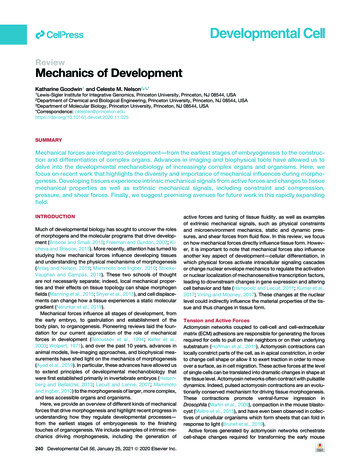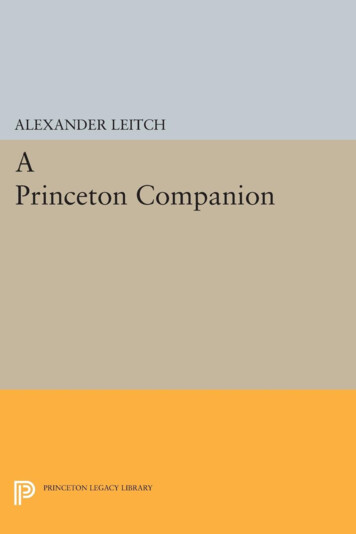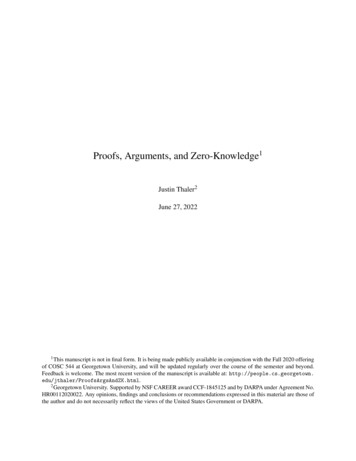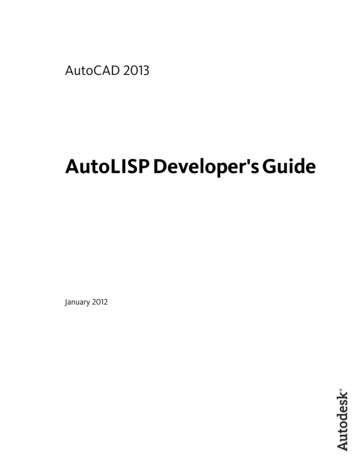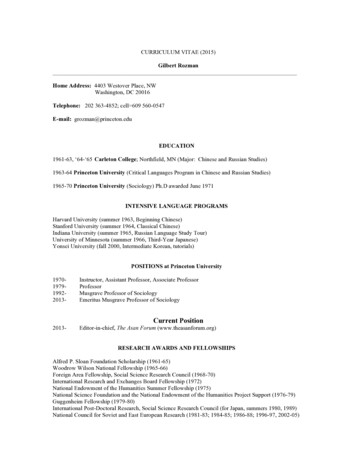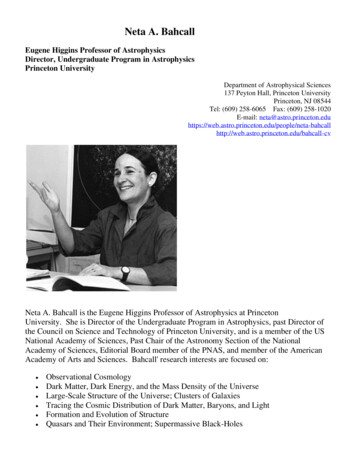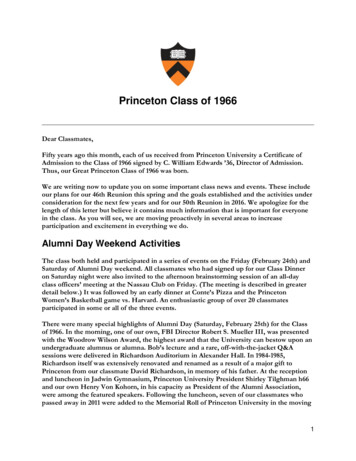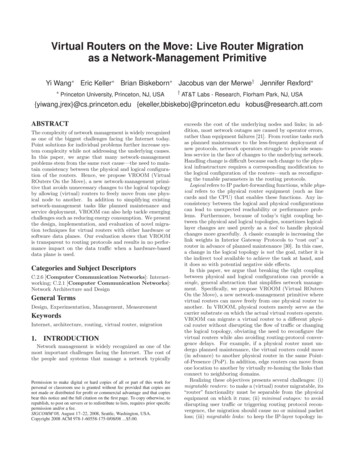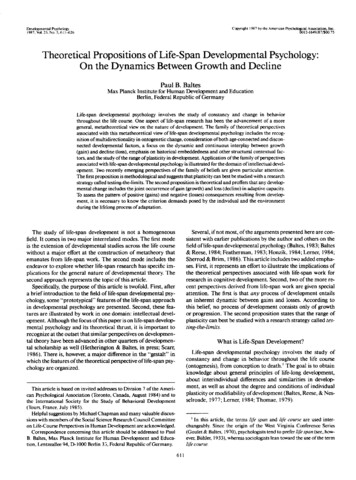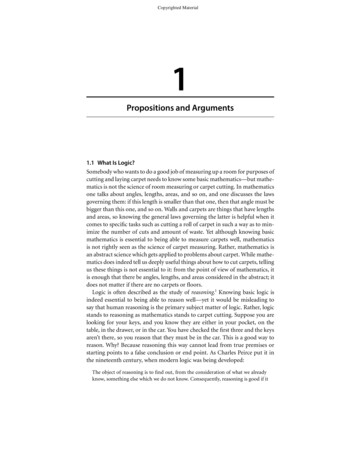
Transcription
Copyrighted Material1Propositions and Arguments1.1 What Is Logic?Somebody who wants to do a good job of measuring up a room for purposes ofcutting and laying carpet needs to know some basic mathematics—but mathe matics is not the science of room measuring or carpet cutting. In mathematicsone talks about angles, lengths, areas, and so on, and one discusses the lawsgoverning them: if this length is smaller than that one, then that angle must bebigger than this one, and so on. Walls and carpets are things that have lengthsand areas, so knowing the general laws governing the latter is helpful when itcomes to specific tasks such as cutting a roll of carpet in such a way as to min imize the number of cuts and amount of waste. Yet although knowing basicmathematics is essential to being able to measure carpets well, mathematicsis not rightly seen as the science of carpet measuring. Rather, mathematics isan abstract science which gets applied to problems about carpet. While mathe matics does indeed tell us deeply useful things about how to cut carpets, tellingus these things is not essential to it: from the point of view of mathematics, itis enough that there be angles, lengths, and areas considered in the abstract; itdoes not matter if there are no carpets or floors.Logic is often described as the study of reasoning.1 Knowing basic logic isindeed essential to being able to reason well—yet it would be misleading tosay that human reasoning is the primary subject matter of logic. Rather, logicstands to reasoning as mathematics stands to carpet cutting. Suppose you arelooking for your keys, and you know they are either in your pocket, on thetable, in the drawer, or in the car. You have checked the first three and the keysaren’t there, so you reason that they must be in the car. This is a good way toreason. Why? Because reasoning this way cannot lead from true premises orstarting points to a false conclusion or end point. As Charles Peirce put it inthe nineteenth century, when modern logic was being developed:The object of reasoning is to find out, from the consideration of what we alreadyknow, something else which we do not know. Consequently, reasoning is good if it
Copyrighted Materialbe such as to give a true conclusion from true premises, and not otherwise. [Peirce,1877, para. 365]This is where logic comes in. Logic concerns itself with propositions—thingsthat are true or false—and their components, and it seeks to discover laws gov erning the relationships between the truth or falsity of different propositions.One such law is that if a proposition offers a fixed number of alternatives (e.g.,the keys are either (i) in your pocket, (ii) on the table, (iii) in the drawer, or(iv) in the car), and all but one of them are false, then the overall propositioncannot be true unless the remaining alternative is true. Such general laws abouttruth can usefully be applied in reasoning: it is because the general law holdsthat the particular piece of reasoning we imagined above is a good one. Thelaw tells us that if the keys really are in one of the four spots, and are not in anyof the first three, then they must be in the fourth; hence the reasoning cannotlead from a true starting point to a false conclusion.Nevertheless, this does not mean that logic is itself the science of reasoning.Rather, logic is the science of truth. (Note that by “science” we mean simplysystematic study.)2 As Gottlob Frege, one of the pioneers of modern logic,put it:Just as “beautiful” points the ways for aesthetics and “good” for ethics, so do wordslike “true” for logic. All sciences have truth as their goal; but logic is also concernedwith it in a quite different way: logic has much the same relation to truth as physicshas to weight or heat. To discover truths is the task of all sciences; it falls to logic todiscern the laws of truth. [Frege, 1918–19, 351]One of the goals of a baker is to produce hot things (freshly baked loaves). It isnot the goal of a baker to develop a full understanding of the laws of heat: thatis the goal of the physicist. Similarly, the physicist wants to produce true things(true theories about the world)—but it is not the goal of physics to develop afull understanding of the laws of truth. That is the goal of the logician. Thetask in logic is to develop a framework in which we can give a detailed—yetfully general—representation of propositions (i.e., those things which are trueor false) and their components, and identify the general laws governing theways in which truth distributes itself across them.Logic, then, is primarily concerned with truth, not with reasoning. Yet logicis very usefully applied to reasoning—for we want to avoid reasoning in waysthat could lead us from true starting points to false conclusions. Furthermore,just as mathematics can be applied to many other things besides carpet cutting,logic can also be applied to many other things apart from human reasoning.For example, logic plays a fundamental role in computer science and com puting technology, it has important applications to the study of natural andartificial languages, and it plays a central role in the theoretical foundations ofmathematics itself.4Chapter 1 Propositions and Arguments
Copyrighted Material1.2 PropositionsWe said that logic is concerned with the laws of truth. Our primary objects ofstudy in logic will therefore be those things which can be true or false—andso it will be convenient for us to have a word for such entities. We shall usethe term “proposition” for this purpose. That is, propositions are those thingswhich can be true or false. Now what sort of things are propositions, and whatis involved in a proposition’s being true or false? The fundamental idea is this:a proposition is a claim about how things are—it represents the world as beingsome way; it is true if the world is that way, and otherwise it is false. This ideagoes back at least as far as Plato and Aristotle:SOCRATES: But how about truth, then? You would acknowledge that there is inwords a true and a false?HERMOGENES: Certainly.S: And there are true and false propositions?H: To be sure.S: And a true proposition says that which is, and a false proposition says that whichis not?H: Yes, what other answer is possible? [Plato, c. 360 bc]We define what the true and the false are. To say of what is that it is not, or of whatis not that it is, is false, while to say of what is that it is, and of what is not that it isnot, is true. [Aristotle, c. 350 bc-a, Book IV (r) §7]In contrast, nonpropositions do not represent the world as being thus or so:they are not claims about how things are. Hence, nonpropositions cannot besaid to be true or false. It cannot be said that the world is (or is not) the waya nonproposition represents it to be, because nonpropositions are not claimsthat the world is some way.3Here are some examples of propositions:1. Snow is white.2. The piano is a multistringed instrument.3. Snow is green.4. Oranges are orange.5. The highest speed reached by any polar bear on 11 January 2004 was 31.35 kilome ters per hour.6. I am hungry.Note from these examples that a proposition need not be true (3), that aproposition might be so obviously true that we should never bother saying itwas true (4), and that we might have no way of knowing whether a proposition1.2 Propositions5
Copyrighted Materialis true or false (5). What these examples do all have in common is that theymake claims about how things are: they represent the world as being someway. Therefore, it makes sense to speak of each of them as being true (i.e., theworld is the way the proposition represents it to be) or false (things aren’t thatway)—even if we have no way of knowing which way things actually are.Examples of nonpropositions include:7. Ouch!10. Where are we?8. Stop it!11. Open the door!9. Hello.12. Is the door open?It might be appropriate or inappropriate in various ways to say “hello” (or“open the door!” etc.) in various situations—but doing so generally couldnot be said to be true or false. That is because when I say “hello,” I do notmake a claim about how the world is: I do not represent things as being thusor so.4 Nonpropositions can be further subdivided into questions (10, 12),commands (8, 11), exclamations (7, 9), and so on. For our purposes thesefurther classifications will not be important, as all nonpropositions lie outsideour area of interest: they cannot be said to be true or false and hence lie outsidethe domain of the laws of truth.1.2.1 ExercisesClassify the following as propositions or nonpropositions.1. Los Angeles is a long way from New York.2. Let’s go to Los Angeles!3. Los Angeles, whoopee!4. Would that Los Angeles were not so far away.5. I really wish Los Angeles were nearer to New York.6. I think we should go to Los Angeles.7. I hate Los Angeles.8. Los Angeles is great!9. If only Los Angeles were closer.10. Go to Los Angeles!1.2.2 Sentences, Contexts, and Propositions5In the previous section we stated “here are some examples of propositions,”followed by a list of sentences. We need to be more precise about this. The6Chapter 1 Propositions and Arguments
Copyrighted Materialidea is not that each sentence (e.g., “I am hungry”) is a proposition. Rather,the idea is that what the sentence says when uttered in a certain context—theclaim it makes about the world—is a proposition.6 To make this distinctionclear, we first need to clarify the notion of a sentence—and to do that, we needto clarify the notion of a word: in particular, we need to explain the distinctionbetween word types and word tokens.7Consider a word, say, “leisure.” Write it twice on a slip of paper, like so:leisureleisureHow many words are there on the paper? There are two word tokens on thepaper, but only one word type is represented thereon, for both tokens are ofthe same type. A word token is a physical thing: a string of ink marks (a flatsculpture of pigments on the surface of the paper), a blast of sound waves, astring of pencil marks, chalk marks on a blackboard, an arrangement of paintmolecules, a pattern of illuminated pixels on a computer screen—and so on,for all the other ways in which words can be physically reproduced, whetherin visual, aural, or some other form. A word token has a location in space andtime: a size and a duration (i.e., a lifespan: the period from when it comesinto existence to when it goes out of existence). It is a physical object embed ded in a wider physical context. A word type, in contrast, is an abstract object:it has no location in space or time—no size and no duration. Its instances—word tokens—each have a particular length, but the word type itself does not.(Tokens of the word type “leisure” on microfilm are very small; tokens on bill boards are very large. The word type itself has no size.) Suppose that a teacherasks her pupils to take their pencils and write a word in their notebooks. Shethen looks at their notebooks and makes the following remarks:1. Alice’s word is smudged.2. Bob and Carol wrote the same word.3. Dave’s word is in ink, not pencil.4. Edwina’s word is archaic.In remark (1) “word” refers to the word token in Alice’s book. The teacher issaying that this token is smudged, not that the word type of which it is a tokenis smudged (which would make no sense). In remark (2) “word” refers to theword type of which Bob and Carol both produced tokens in their books. Theteacher is not saying that Bob and Carol collaborated in producing a singleword token between them (say by writing one letter each until it was finished);she is saying that the two tokens that they produced are tokens of the oneword type. In remark (3) “word” refers to the word token in Dave’s book. Theteacher is saying that this token is made of ink, not that the word type of which1.2 Propositions7
Copyrighted Materialit is a token is made of ink (which, again, would make no sense). In remark(4) “word” refers to the word type of which Edwina produced a token in herbook. The teacher is not saying that Edwina cut her word token from an oldmanuscript and pasted it into her book; she is saying that the word type ofwhich Edwina produced a token is no longer in common use.Turning from words to sentences, we can make an analogous distinctionbetween sentence types and sentence tokens. Sentence types are abstract ob jects: they have no size, no location in space or time. Their instances—sentencetokens—do have sizes and locations. They are physical objects, embedded inphysical contexts: arrangements of ink, bursts of sound waves, and so on. Asentence type is made up of word types in a certain sequence;8 its tokens aremade up of tokens of those word types, arranged in corresponding order. If Isay that the first sentence of Captain Cook’s log entry for 5 June 1768 coveredone and a half pages of his logbook, I am talking about a sentence token. If Isay that the third sentence of his log entry for 8 June is the very same sentenceas the second sentence of his log entry for 9 June, I am talking about a sentencetype (I am not saying of a particular sentence token that it figures in two sep arate log entries, because, e.g., he was writing on paper that was twisted andspliced in such a way that when we read the log, we read a certain sentencetoken once, and then later come to that very same token again).9§Now let us return to the distinction between sentences and propositions. Con sider a sentence type (e.g., “I am hungry”). A speaker can make a claim aboutthe world by uttering this sentence in a particular context. Doing so will in volve producing a token of the sentence.10 We do not wish to identify theproposition expressed—the claim about the world—with either the sentencetype or this sentence token, for the reasons discussed below.To begin, consider the following dialogue:Alan: Lunch is ready. Who’s hungry?Bob: I’m hungry.Carol: I’m hungry.Dave: I’m not.Bob and Carol produce different tokens (one each) of the same sentence type.They thereby make different claims about the world. Bob says that he is hun gry; Carol says that she is hungry. What it takes for Bob’s claim to be true isthat Bob is hungry; what it takes for Carol’s claim to be true is that Carol ishungry. So while Bob and Carol both utter the same sentence type (“I’m hun gry”) and both thereby express propositions (claims about the world), theydo not express the same proposition. We can be sure that they express differ ent propositions, because what Bob says could be true while what Carol says8Chapter 1 Propositions and Arguments
Copyrighted Materialis false—if the world were such that Bob was hungry but Carol was not—orvice versa—if the world were such that Carol was hungry but Bob was not. Itis a sure sign that we have two distinct propositions—as opposed to the sameproposition expressed twice over—if there is a way things could be that wouldrender one of them true and the other false.11 So one sentence type can beused to express different propositions, depending on the context of utterance.Therefore, we cannot, in general, identify propositions with sentence types.12Can we identify propositions with sentence tokens? That is, if a speakermakes a claim about the world by producing a sentence token in a particularcontext, can we identify the claim made—the proposition expressed—withthat sentence token? We cannot. Suppose that Carol says “Bob is hungry,” andDave also says “Bob is hungry.” They produce two different sentence tokens(one each); but (it seems obvious) they make the same claim about the world.Two different sentence tokens, one proposition: so we cannot identify theproposition with both sentence tokens.13 We could identify it with just oneof the tokens—say, Carol’s—but this would be arbitrary, and it would alsohave the strange consequence that the claim Dave makes about the world is aburst of sound waves emanating from Carol. Thus, we cannot happily identifypropositions with sentence tokens.Let us recapitulate. A proposition is a claim about how things are: it repre sents the world as being some way. It is true if things are the way it representsthem to be (saying it how it is) and otherwise it is false (saying it how it isn’t).The main way in which we make claims about the world—that is, expresspropositions—is by uttering sentences in contexts. Nevertheless, we do notwish to identify propositions with sentences (types or tokens), because of thefollowing observations:.One sentence type can be used (in different contexts) to make distinctclaims (the example of “I’m hungry,” as said by Bob and Carol).The same claim can be made using distinct sentence types (the exampleof John and Johann’s sentences in n. 12).The same claim can be made using distinct sentence tokens (the exampleof Carol’s and Dave’s tokens of “Bob is hungry”).It should be said that we have not discussed these issues in full detail.14 Wehave, however, said enough to serve our present purposes. For we do notwish to deny vehemently and absolutely that propositions might (in the finalanalysis) turn out to be sentences of some sort. Rather, we simply wish toproceed without assuming that propositions—our main objects of study—can be reduced to something more familiar, such as sentences. In light of theproblems involved in identifying propositions with sentences, our decision torefrain from making any such identification is well motivated.1.2 Propositions9
Copyrighted MaterialSo far so good, then. But now, if propositions are not sentences, then whatare they? Propositions might start to seem rather mysterious entities. I canpicture tokens of the sentence “I am hungry,” and perhaps, in some sense, Ican even picture the sentence type (even though it is an abstract object). Buthow do I picture the proposition that this sentence expresses (when a certainspeaker utters it in a particular context)? It would be a mistake in methodologyto try to answer this question in detail at this point. One of the tasks of logic—the science of truth—is to give us an understanding of propositions (the thingsthat are true or false). What we need in advance of our study of logic—that is,what we need at the present point in this book—is a rough idea of what it is ofwhich we are seeking a precise account. (Such a rough idea is needed to guideour search.) But we now have a rough idea of what propositions are: they areclaims about the world; they are true if the world is as claimed and otherwisefalse; they are expressed by sentences uttered in context but are not identicalwith sentence types or with tokens thereof. The detailed positive account ofpropositions will come later (§11.4).§There is one more issue to be discussed before we close this section. We haveseen that, to determine a proposition, we typically need not just a sentencetype but also a context in which that sentence is uttered. For example, for thesentence type “I am hungry” to determine a proposition, it needs to be utteredby someone in a particular context. When Bob utters it, he then expresses theproposition that he (Bob) is hungry (that is how the world has to be for whathe says to be true); when Carol utters it, she then expresses the propositionthat she (Carol) is hungry (that is how the world has to be for what she says tobe true); and so on. This general picture is widely accepted. However, exactlyhow it comes about that a particular proposition is expressed by uttering acertain sentence in a specific context is a topic of great controversy. Some ofthe factors that potentially play a role in this process are:1. The meaning of the sentence type. (This is usually thought of as deter mined by the meanings of the sentence’s component word types togetherwith the syntax—the grammatical structure—of the sentence. The mean ing of a word type is what a speaker has to know to understand that word;it is what a dictionary entry for that word aims to capture.)2. Facts about the context of utterance. (Relevant facts include the time andplace of the context, and the identity of the speaker.)3. Facts about the speaker (e.g., what she intended to convey by uttering thesentence she uttered in the context).10Chapter 1 Propositions and Arguments
Copyrighted MaterialTogether, these facts—and perhaps more besides—determine what is said bythe speaker in uttering a certain sentence in a certain context; that is, whatclaim she is making about the world—which proposition is expressed.15 Thatmuch is widely agreed; the controversy enters when it comes to the questionof exactly how the labor of determining a particular proposition is dividedbetween the contributing factors mentioned above: what role each plays. Wedo not need to enter these controversies here, however: for in logic we areconcerned with propositions themselves, not with how exactly they come to beexpressed by uttering sentences in contexts.16 This is not to say that in this bookwe shall be able to get by without sentences. On the contrary, our chief wayof getting in touch with propositions is via the sentences that express them.The point to keep in mind is that our primary interest is in the propositionsexpressed: sentences are simply a route to these propositions.171.3 ArgumentsWe said that the laws of truth underwrite principles of good reasoning. Rea soning comes packaged in all sorts of different forms in ordinary speech,writing, and thought. To facilitate discussion of reasoning, it will be useful tointroduce a standard form in which any ordinary piece of reasoning can be rep resented. For this purpose we introduce the notion of an argument. As was thecase with the term “proposition,” our usage of the term “argument” is a tech nical one that is abstracted from one of the ordinary meanings of the term. Inour usage, an argument is a sequence of propositions. We call the last proposi tion in the argument the conclusion: intuitively, we think of it as the claim thatwe are trying to establish as true through our process of reasoning. The otherpropositions are premises: intuitively, we think of them as the basis on whichwe try to establish the conclusion. There may be any finite number of premises(even zero). We may present arguments in the following format:Premise 1Premise 2ConclusionHere we use a horizontal line to separate the conclusion from the premises.The conclusion can also be marked by the term “Therefore” (often abbreviatedas ):Premise 1Premise 2Premise 3 Conclusion1.3 Arguments11
Copyrighted MaterialWe may also present an argument in a linear fashion, with the premises sepa rated by commas and the conclusion separated by a slash and the “therefore”symbol:Premise 1, Premise 2, Premise 3, Premise 4 / ConclusionFor example, consider the following piece of ordinary reasoning. I do nothave a watch, and I am wondering what time it is. I notice that Sesame Streetis just starting on television, and I know from my acquaintance with thetimetable that this show starts at 8.30. I conclude that it is now 8.30. We canrepresent this piece of reasoning as the following argument:If Sesame Street is starting, it is 8.30.Sesame Street is starting. It is 8.30.When looking at a piece of reasoning phrased in ordinary language witha view to representing it as an argument, we identify the conclusion as theproposition that the speaker is trying to establish—to give reasons for—andthe premises as the reasons given in support of that conclusion. Phrases thatcommonly indicate conclusions in ordinary reasoning include “therefore,”“hence,” “thus,” “so,” and “it follows that;” phrases that commonly indicatepremises include “because,” “since,” and “given that.” However, these wordsare not always present, and even when they are they do not always indicateconclusions and premises, respectively. Hence there is no recipe we can followmechanically when representing ordinary reasoning in the form of an argu ment: we must always think carefully about what is being said in the ordinaryreasoning—about what it is that the reasoner is trying to establish (this will bethe conclusion) and about what reasons are being given in support of this con clusion (these will be the premises). One point to note carefully is that whenwe represent a piece of reasoning as an argument in our technical sense—thatis, a sequence of propositions—we always put the conclusion last. In ordinaryEnglish, however, the conclusion of a piece of reasoning is not always what isstated last.Let’s consider another example. When working out what to serve a guestfor breakfast, someone might reason as follows: Mary must like marmalade,because she is English, and all English people like marmalade. Here theconclusion—the proposition that the reasoning is supposed to establish—isthe thing said first: that Mary likes marmalade. The premises are the reasonsgiven in support of this conclusion—that Mary is English, and that all Englishpeople like marmalade. So we represent this piece of reasoning as the followingargument:12Chapter 1 Propositions and Arguments
Copyrighted MaterialMary is English.All English people like marmalade.Therefore, Mary likes marmalade.Note that we count any sequence of one or more propositions as an argu ment. Thus we count as arguments things that do not correspond to anythingwe would ordinarily regard as a piece of reasoning. For example:Snow is green.It has been a wet winter.This generosity when it comes to counting things as arguments, while it mightinitially seem silly, is in fact good, for the following reason. As we shall dis cuss in the next section, one of our aims is to develop an account that willenable us to determine of any piece of reasoning—no matter what its sub ject matter—whether it is valid. (We shall see what validity is, and why it isimportant, below.) The more things we count as arguments, the more widelyapplicable our account of validity will be. If we were more stringent about whatcounts as an argument, then there would be a worry that some piece of rea soning to which we want our account to apply cannot be represented as anargument (in the more restricted sense) and so would be left out of account.Our present approach avoids this worry. All we are assuming is that any pieceof reasoning can be represented as a sequence of propositions (an argument),one of which (the conclusion) is what the piece of reasoning is intended to es tablish, and the rest of which (the premises) are intended to provide supportfor that conclusion. That is, every piece of reasoning can be represented as anargument. The fact that the opposite does not hold—that not every argument(in our technical sense) corresponds to an ordinary piece of reasoning—willnot matter.1.3.1 ExercisesRepresent the following lines of reasoning as arguments.1. If the stock market crashes, thousands of experienced investors will lose alot of money. So the stock market won’t crash.2. Diamond is harder than topaz, topaz is harder than quartz, quartz isharder than calcite, and calcite is harder than talc, therefore diamond isharder than talc.3. Any friend of yours is a friend of mine; and you’re friends with everyoneon the volleyball team. Hence, if Sally’s on the volleyball team, she’s afriend of mine.1.3 Arguments13
Copyrighted Material4. When a politician engages in shady business dealings, it ends up on pageone of the newspapers. No South Australian senator has ever appearedon page one of a newspaper. Thus, no South Australian senator engagesin shady business dealings.1.4 Logical ConsequenceConsider the following argument:1. The rabbit ran down the left path or the right path.The rabbit did not run down the left path. The rabbit ran down the right path.It is said that dogs exhibit a grasp of logic by reasoning in this way.18 Suppose adog is chasing a rabbit through the forest, when it comes to a fork in the path.The dog does not know which way the rabbit has gone, but it knows (becausethe undergrowth is impenetrable) that it has gone left or right (first premise).The dog sniffs down one path—say, the left one—trying to pick up the scent.If it does not pick up the scent, then it knows the rabbit has not gone downthe left path (second premise). In this case the dog simply runs down the rightpath, without stopping to pick up the scent. For the dog knows, purely on thebasis of logic—that is, without having to determine so by sniffing—that therabbit has gone right: it must have, because it had to go left or right, and it didnot go left, so that leaves only the possibility that it went right.The argument is a good one. What exactly is good about it? Well, two things.The first is that given that the premises are true, there is no possibility of theconclusion’s not being true. We can put the point in various ways:.The truth of the premises guarantees the truth of the conclusion.It is impossible for the premises all to be true and the conclusion not be true.There is no way for the premises all to be true without the conclusion being true.We call this property—the property that an argument has when it is impos sible for the premises to be true and the conclusion false—necessary truthpreservation (NTP), and we call an argument with this property necessarilytruth-preserving (NTP).19Consider another example:202. All kelpies are dogs.Maisie is a dog. Maisie is a kelpie.14Chapter 1 Propositions and Arguments
Copyrighted MaterialDogsKelpiesMaisieFigure 1.1. The argument is validCan we imagine a situation in which the premises are both true but the conclu sion is false? Yes: suppose that (as in actual fact) all kelpies are dogs (so the firstpremise is true) and suppose that Maisie is a beagle (and hence a dog—so thesecond premise is true); in this case the conclusion is false. Hence argument(2) is not NTP.Now consider a third example:3. All kelpies are dogs.Maisie is a kelpie. Maisie is a dog.Can we imagine a situation in which the premises are both true but the con clusion is false? No. Supposing the first premise to be true means supposingthat (to represent the situation visually) a li
idea is not that each sentence (e.g., "I am hungry") is a proposition. Rather, the idea is that . what the sentence says. when uttered in a certain context—the claim it makes about the world—is a proposition. 6 . To make this distinction clear, we first need to clarify the notion of a . sentence —and to do that, we need to clarify .
